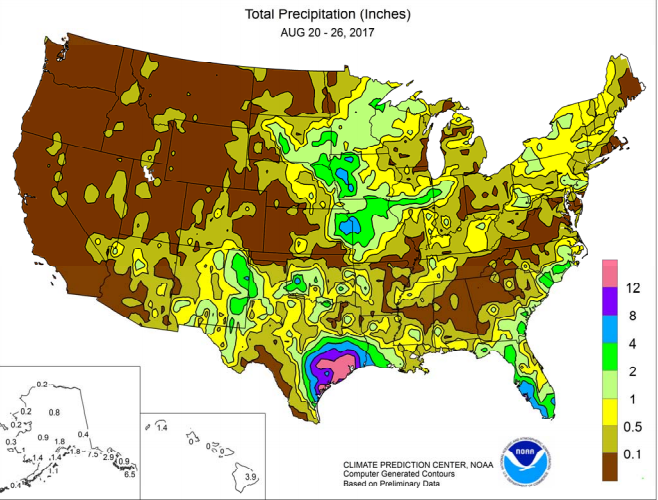
Rainfall never seen before from one storm, the storm that will hang in memories for years, Harvey, has destroyed the Houston metropolitan area and many surrounding counties. Through Sunday, August 27, widespread 10- to 30-inch rainfall totals stretched northeastward from near the hurricane’s point of landfall near Rockport, TX, into southwestern Louisiana. Although Harvey’s winds also caused varying degrees of damage in the western Gulf Coast region, major impacts were mostly limited to areas along the middle Texas coast. Prior to Harvey’s late-week arrival and outside of the hurricane’s sphere of influence, relatively tranquil late-summer
weather favored fieldwork and crop maturation across large parts of the country.
Elsewhere, pockets of heavy rain were mostly limited to southern sections of the Rockies and Plains; the southern Atlantic region; and the western Corn Belt and environs. Although the Midwestern showers benefited immature summer crops, ongoing cool weather slowed corn and soybean development. Weekly temperatures averaged at least 5°F below normal in parts of the upper Midwest.
Generally cool weather also covered portions of the Plains and Northeast.
In contrast, hot, humid weather gripped the Southeast, while late season heat prevailed across much of the West. Mostly dry weather accompanied the Western heat, favoring fieldwork and summer crop maturation. Dry weather extended across the northern High Plains, where drought impacts on rangeland and pastures continued to mount as the winter wheat planting season approached.
Prior to Harvey’s arrival, rainfall highlights were limited to a few small areas. On August 21, heavy rain in the western Corn Belt and neighboring areas led to daily-record totals in locations such as Kansas City, MO (4.08 inches), and Topeka, KS (3.83inches).
About the Author(s)
You May Also Like




